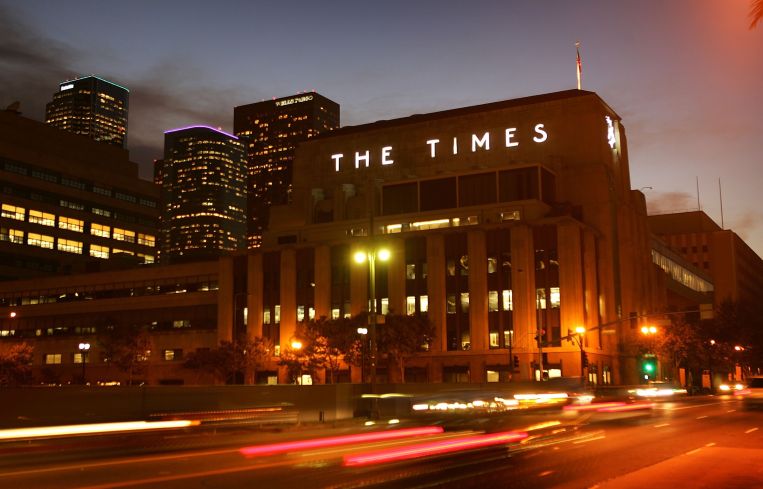Onni Group Inches Closer to Demolishing LA Times Building, Erecting Development
By Alison Stateman November 30, 2018 12:24 pm
reprints
A committee of the L.A. City Council ruled against a bid to secure historic cultural monument status for one of three former Los Angeles Times buildings on Nov. 27, helping clear the way for some of the Onni Group’s redevelopment plans, as The LA Times first reported.
The council’s Planning and Land Use Management Committee (PLUM) ruled against establishing the newest of the three structures, designed by William Pereira, as a protected historical cultural monument. Buildings dating back to the 1930s and 1940s deserve monument status, the committee declared, but not the building designed by Pereira in 1973.
The amended proposal still calls for retaining the oldest of the structures—the two Art Deco-style buildings on the east side of the block along Spring Street that once included The LA Times‘ newsroom.
The city needs housing, Councilman Gilbert Cedillo and a member of PLUM said, declaring himself “pro-development” and in favor of union workers getting jobs to build the proposed towers, as The LA Times reported.
A representative from Cedillo’s office did not return subsequent calls for more details on the committee’s decision.
Onni, a Canadian real estate developer, which owns the block near City Hall formerly known as Times Mirror Square, announced in late 2016 its intention to demolish a parking garage, former printing plant and the Pereira office building to make room for two apartment towers of 37 and 53 stories with more than 1,100 luxury apartments and ground-floor shops.
(The LA Times relocated to offices in El Segundo this summer at the behest of new owner Patrick Soon-Shiong, when the paper’s lease expired on June 30, rejecting a rent hike of $1 million per month to remain in downtown Los Angeles, as Commercial Observer previously reported.)
If the remaining two LA Times buildings are declared city monuments by the full city council vote, on or before Dec. 12 the decision could delay demolition for delay any demolition for as much as a year. Delays would give the city time to consider alternate uses for the buildings or to encourage developers to keep parts of the historic structures intact.
Richard Schave, a co-founder of L.A. history bus tour company Esotouric, told CO he has been working on gaining historic monument status for the Times Mirror Square property for the last decade.
Preservationists, led by Schave, filed an application to officially recognize three out of the five interconnected structures as historic monuments with The Cultural Heritage Commission (CHC) in May. The CHC approved the measure and forwarded it for consideration to the city council’s Planning and Land Use Management Committee as CO previously reported.
He said the ruling to omit the Pereira building from historic consideration by the Planning and Land Use Management Committee was unheralded. (In addition to the Times Mirror property, the late Pereira also designed the Transamerica Pyramid in San Francisco, CBS Television City in L.A.’s Fairfax district and the futuristic Theme Building at the Los Angeles International Airport.)
“It’s a terrible precedent. I think that everyone interested in historic preservation in Los Angeles should take note and be very concerned,” Schave said. Despite meeting with senior policy staff at Council District 14, in which the property in question is located, as well as requesting meetings with Onni before the PLUM vote to “understand their intent,” the property owner rejected meeting with him and he said he had no indication the nomination would be split.
“If we had been in a meeting with them and they told me they were going to split the application, I would have laughed and I wouldn’t have believed them,” he said.
Mark Spector, the vice president of development for California at Onni, did not return a call for comment.
No matter what the City Council decides, Schave is not backing down, saying, “I assure you, my hands are not tied,” though he declined to reveal his plans.
“They have dramatically altered the precedents for dealing with historic designation applications through the Planning and Land Use Management Committee,” Schave said. “If they think this is anything short of a magnitude 8 earthquake in the preservation community, they are sorely mistaken.”


